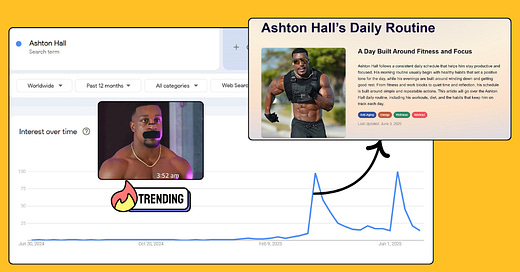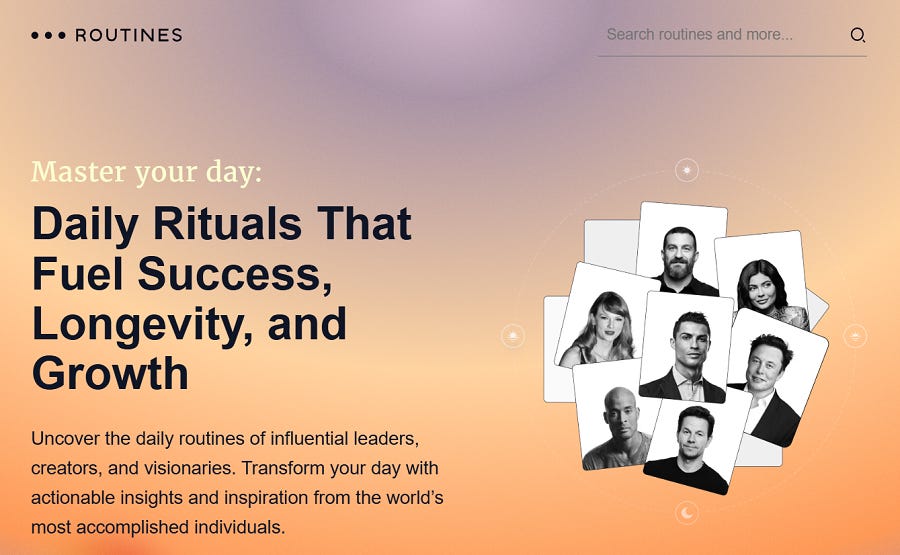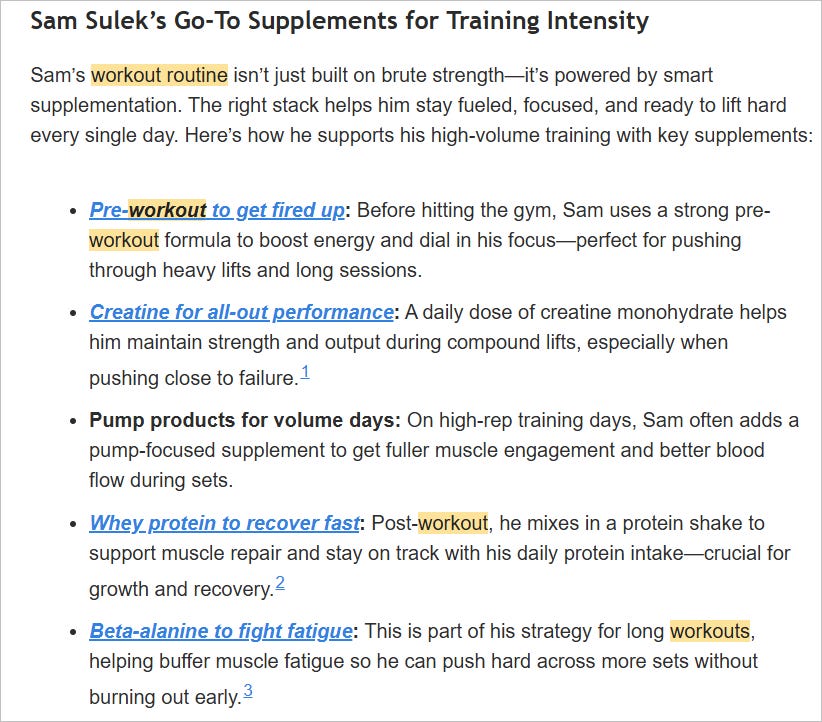⭐ How Routines.Club grew from 4K to 33K organic visits a month
SEO case study: How Routines.Club grew from 4K to 33K organic visits a month
Hey👋, Rafiqul from SEO Growth Notes.
In this episode, you’ll learn how Routines Club turned a simple content idea into a high-traffic, high-revenue website without relying only on SEO tricks.
This breakdown will show you how to build a brand, grow loyal readers, and turn traffic into real revenue.
When users begin their search by typing your brand name instead of a keyword, you've won at SEO.
Routines.club (a content affiliate website) is a prime SEO case study following this approach.
The website receives over 33,000 organic visits each month, with a traffic value exceeding $ 28K.
Today, we will break down what makes Routines.club a successful content affiliate website, where most other pure content sites are struggling in 2025.
Key highlights and background
Routines.club is a content-based website that shares daily routines and habits of well-known figures in health, wellness, and self-improvement. Its goal is to show how influential people optimize their productivity and performance.
Influencer Focus: Features routines of figures like Dr. Andrew Huberman and Dr. David Sinclair.
Monetization: Earns through affiliate links to products mentioned in routines.
User Engagement: Encourages visitors to try and adopt similar habits.
Business Success:
Achieved $200,000 in EBITDA in the first 6 months.
Projected to hit $600K–$1M annually.
Content Formats: The site focuses on a couple of content templates, such as daily routines, supplement list of influential leaders, travel routine, workout routine, and so on.
Note: Back in 2023, I featured Routines.club when it was receiving around 4K organic monthly visits.
Let’s analyze what’s working so well with Routines.club
1. Content experience and UX design
First, Google the search term ‘Tim Ferriss daily routine’ and you will notice that all other pages (except routines.club) are typical blog articles that look similar to this:
Almost every other page for similar search queries looks like a typical lengthy blog article.
In contrast, Routines.club played it smart by improving the content experience instead of following so-called SEO best practices.
When you compare other similar articles with routines.club, you will find a huge content experience difference in terms of UX design, information architecture, visual elements, etc.
Here’s the routines.club page that is ranking #1 for the same search query:
The main reason this approach worked is that once people visit the site, they remember the experience (and site name). The next time they look for similar information, they type the website URL directly into their browser.
In fact, 34% of traffic comes as a direct channel, according to Similarweb data.
This sends a strong signal, arguably the strongest SEO factor today, to search engines that user intent matches user satisfaction.
2. Smart selection of trending influential figures
Routines.club scales content efficiently using structured content templates like:
{influencer_name} morning routine/workout routine/sleep routine/diet routine
{influencer_name} workout routine
{influencer_name} supplement list
This makes it easy to publish many pages that target what people are searching for.
But what really helps the site stand out is how quickly it covers trending people and topics. Instead of only writing about well-known names, the team watches social media (especially fitness creators) to spot new influencers and rising trends.
They’ve created pages on viral topics like cold plunges, 5-day fasting, and Ashton Hall, who started gaining attention in March 2025 for his intense morning routine.
They published his daily routine on April 8, 2025, just as people began searching for him. This helped them rank fast and attract thousands of visitors.
By mixing evergreen content with trending topics, Routines.club stays fresh and keeps growing traffic.
3. Building an audience through a newsletter
The website’s biggest strength isn’t just its organic rankings — it’s the newsletter audience.
This gives Routines.club a direct line to its readers, helping them build trust, drive repeat visits, and earn affiliate revenue or brand sponsorships over time.
They mainly grow their list through a simple pop-up that encourages readers to subscribe.
Many content websites that once had thousands of monthly visitors have dropped to just a few hundred. One common reason? They never built a newsletter list. When their Google traffic dropped, they had no way to reach their audience.
Routines.club avoids this risk by not depending fully on search traffic. That’s a key lesson for content-heavy websites that don’t sell products or services yet:
If you’re still relying only on SEO, now’s the time to start building your email list.
Here’s what I’d do to scale the SEO performance:
Find popular or trending influential people that users are actively searching for online.
Check search volume to decide which routines to publish first.
Group routine pages by interest, such as entrepreneurs, athletes, tech founders, or wellness experts — so readers can easily browse by category.
Add basic on-page SEO, including metadata, headers, and structured data for better visibility.
Reach out to the influencers for original quotes or insights — this makes the content more unique and increases chances they’ll share it.
Train writers or researchers to create high-quality content by pulling insights from podcasts, interviews, and books — since this format is more research-heavy than typical blog posts.
Key SEO lessons from Routines Club
Do not rely only on Google traffic
Build an audience you control—through email, community, or app. If rankings drop, you still have users.Your site’s experience matters more than keywords
Make your site easy to read, visually clean, and pleasant to use. Good UX builds brand memory and trust.Give users a reason to remember your site
Stand out with structure, design, or voice. If they remember you, they’ll come back—and even search your brand name.Be fast with content, not just right
If you see a trend rising, publish early. First-mover advantage matters more than waiting for perfection.Build systems, not one-off posts
Use repeatable content frameworks so you can publish consistently at scale without starting from scratch every time.Pair search demand with social signals
Don’t just look at search volume. Watch YouTube, TikTok, Reddit, and Instagram to spot what people will search next.Add depth, not just surface-level content
Pull real insights from podcasts, books, interviews, or expert talks. This builds trust and attracts links naturally.Turn visitors into subscribers
Use smart pop-ups, lead magnets, or exclusive updates to turn passive traffic into an email list or community.Make monetization part of the content, not the sidebar
Add affiliate links or offers inside useful content, not outside of it. Keep trust high and distractions low.Treat your content site like a brand, not a project
Brand-first sites win in the long run. Focus on recognition, voice, and user loyalty—not just ranking for a list of keywords.
2 free SEO tools I built for you:
🔍 SERP Similarity Checker
Compare two keywords side by side and see how much their search results overlap. Helps you decide if you should target both keywords on one page or separate pages.
Try the SERP similarly tool for multiple keywords
🧠 Audience Research Assistant
Discover real user questions, pain points, and conversations from platforms like Reddit, Quora, and LinkedIn. Perfect for planning content that speaks to what people actually care about.
Try the audience research assistance for free.













